Discuss Measurement of loudness based on sound power
Audio and RF Circuits
When you have completed your exam and reviewed your answers, click Submit Exam. Answers will not be recorded until you hit Submit Exam. If you need to exit before completing the exam, click Cancel Exam.
Questions 1 to 20: Select the best answer to each question. Note that a question and its answers may be split across a page break, so be sure that you have seen the entire question and all the answers before choosing an answer.
1. In foggy weather, the captain of a ferry boat toots the boat’s whistle and then counts the number of seconds it takes for the whistle’s echo to bounce off a nearby island. If the round-trip time of the whistle sound is 6 seconds, what is the distance to the island? (Hint: Note that the time given is for the round trip to the island. The actual distance to the island is only one way.)
A. 1,650 feet
B. 13,200 feet
C. 3,300 feet
D. 6,600 feet
2. Which of the following is a measurement of loudness based on sound power that’s calibrated in equal steps?
A. The phon
B. The sone
C. The dB
D. The microbar
3. Which of the following statements about mfrared communication systems is correct?
A. An infrared system will generate signals that produce heat.
B. An infrared system can handle only monochrome television signals.
C. No FCC license is required to operate an infrared transmitter.
D. An infrared system can’t be multiplexed.
4. What is the third harmonic of a piano sound with a basic frequency of 660 Hz?
A.660 Hz
B. 1,320 Hz
C. 1,980 Hz
D. 2,640 Hz
5. A circuit that operates without its own pair of wires and that, instead, uses the two pairs of wires from two side circuits is called a/an circuit.
A. wye-delta
B. amplifier
C. phantom
D. triaxial
6. Which of the following circuits, in effect, converts two communications channels to three?
A. A phantom circuit
B. A splitter circuit
C. A wye-delta circuit
D. A delta-wye circuit
7. An industrial company can receive subscription music over an SCA channel
A. if the company has an FCC license for broadcasting.
B. if the SCA broadcasts use an AM broadcast band receiver.
C. when the SCA broadcasts are public property.
D. when the company pays a fee to the subscription music firm.
8. Which of the following would be used with differential amplifiers to minimize interference pickup from electrostatic fields?
A. Twisted-pair shielded cable
B. Single-conductor shielded audio cable
C. Triaxial cable
D. Unshielded copper wire
9. Sound frequencies that are above the range of frequencies that humans can hear are called sounds.
A. infrasonic
B. intrasonic
C. intersonic
D. ultrasonic
10. Which of the following types of conductor is typically used to feed speakers?
A. Triaxial cable
B. Coaxial cable
C. Fiber-optic cable
D. Unshielded wire
11. Assume that a certain piano key, when struck, has a basic frequency of 440 HZ. What is the frequency of the first overtone?
A. 880 Hz
B. 4,400 Hz
C. 1,320 Hz
D. 440 Hz
12. Which of the following should be used to convey video signals, RF signals, and very low-level AF signals?
A. Twisted-pair shielded cable
B. Unshielded copper wire
C. Single-conductor shielded audio cable
D. Coaxial cable
13. If CTCSS tone frequencies interfere noticeably with telephone communications, which of the following is inserted in the line leading to the telephone?
A. A high-pass filter
B. A band-pass filter
C. A low-pass filter
D. A band-reject filter
14. In broadcasting, the letters SCA stand for
A. Strong Channel Authorization.
B. Subsidiary Communications Adjustment.
C. Subsidiary Communications Authorization.
D. Supplementary Communications Audio.
15. A pushbutton telephone has a twelve-button keyboard. When one of the buttons is pressed, the number of tones that will be transmitted is
A. four.
B. one.
C. two.
D. eight.
16. No FCC license is required to operate an infrared transmitter because
A. the signal is transmitted by electromagnetic radation.
B. the signal can’t cause interference to other radio services.
C. an infrared system can’t be multiplexed.
D. an infrared system can handle only monochrome television signals.
17. Assume that a certain piano key, when struck, has a basic frequency of 1,047 Hz. What is the
frequency of the second overtone?
A. 0.1047 Hz
B. 1,047 Hz
C. 3,141 Hz
D. 2,094 Hz
18. In narrow-band FM, the maximum frequency of a transmitted sound is Hz.
A. 4,000
B. 5,000
C. 1,000
D. 12,000
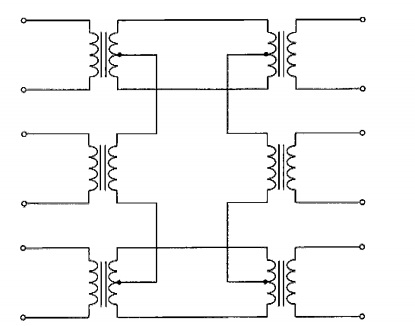
19. Look at the circuit that’s illustrated in the figure above. The purpose of this circuit is to
A. separate out-of-band signals.
B. send two signals through three channels.
C. send three signals through two channels.
D. decode FSK transmissions.
20. For a pressure variation to be perceived as sound, it must occur at a minimum frequency of about Hz.
A. 10
B. 0
C. 20
D. 2
End of exam
Exam: 086047RR – Oscillators, Feedback, and Waveforms
When you have completed your exam and reviewed your answers, click Submit Exam. Answers will not be recorded until you hit Submit Exam. If you need to exit before completing the exam, click Cancel Exam.
Questions 1 to 20: Select the best answer to each question. Note that a question and its answers may be split across a page break, so be sure that you have seen the entire question and all the answers before choosing an answer.
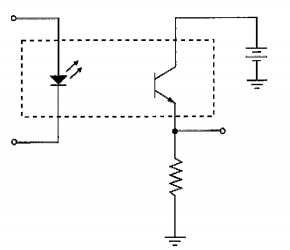
1. The function of the circuit shown in the figure above is to provide electrical between input
and output signals.
A. interference
B. isolation
C. power
D. gain
2. Which of the following types of oscillators generates a signal that has a sawtooth waveform?
A. Colpitts
B. Phase-shift
C. Relaxation
D. Pierce
3. Which of the following circuits is widely used to interface high-speed digital data circuits, and also to protect computers from the high-voltage circuits they control?
A. The twin-T oscillator
B. The Colpitts oscillator
C. The phase-shift oscillator
D. The optical isolator circuit
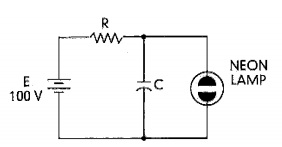
4. Look at the circuit schematic shown in the figure above. Which of the following circuits is represented by this schematic?
A. A phase-shift oscillator circuit
B. A Colpitts oscillator circuit
C. A Pierce oscillator circuit
D. A relaxation oscillator circuit
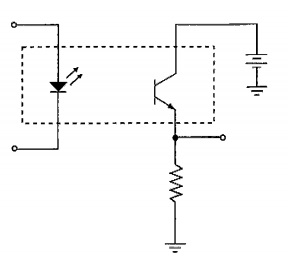
5. Look at the circuit diagram shown in the figure above. The type of circuit shown is a/an circuit.
A. phase-shift oscillator
B. optical isolator
C. twin-T oscillator
D. Armstrong oscillator
6. An advantage of a homodyne receiver over a superheterodyne receiver is that it
A. has better fidelity.
B. receives both AM and FM with the same local oscillator.
C. has greater sensitivity.
D. has no local oscillator.
7. If you want to reduce amplifier distortion, you can use feedback, which gain.
A. negative, decreases
B. negative, increases
C. positive, decreases
D. positive, increases
8. The main feature that distinguishes one sinusoidal oscillator from another is the
A. type of feedback circuit that the circuit uses.
B. coil capacitor ratio.
C. frequency of the output waveform.
D. amount of distortion produced.
9. An oscillator with a feedback loop that uses only resistors and capacitors to determine frequency is called
a oscillator.
A. phase-shift
B. Colpitts
C. multivibrator
D. twin-T
10. Which of the following is used in some military, industrial, and maritime superheterodyne receivers to
eliminate image frequency interference?
A. Double conversion
B. Square-wave oscillator signal
C. Low oscillator frequency
D. UHF oscillator frequency
11. Which of the following devices would you use to stabilize frequency in communications equipment?
A. A quartz ciystal
B. A capacitor
C. A transformer
D. An inductor
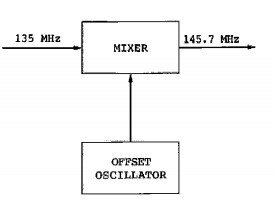
12. Look at the block diagram shown in the figure above. According to the information provided by the diagram, the frequency of the offset oscillator is MHz.
A. 0
B. 10.7
C. 2.5
D. 6.1
13. To determine the frequency at which feedback occurs in a sound system, you can use an instrument called a
A. function generator.
B. transformer.
C. Hartley oscillator.
D. graphic equalizer.
14. In a crystal-controlled oscillator circuit, if high frequency and high stability are needed, the ciystal can be enclosed in a/an to hold the crystal temperature constant.
A. monostable multivibrator
B. amplifier circuit
C. crystal oven
D. transformer housing
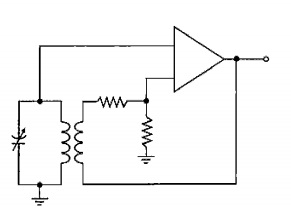
15. Look at the schematic diagram shown in the figure above. What type of oscillator is represented in the circuit?
A. Phase-shift
B. Relaxation
C. Hartley
D. Armstrong
16. A diathermy machine is considered a member of the -heater family.
A. dielectric
B. infrared
C. induction
D. conduction
17. The percent of frequency error is determined by dividing the error by the operating frequency and multiplying by 100. What would be the percent of frequency error of an oscillator that operates at 40 MHz when the oscillator is off by 2,000 Hz?
A. 0.005%
B. 0.002%
C. 0.0005%
D. 0.02%
18. In an amplifier with a very high gain, undesired oscillations are called oscillations.
A. unwarranted
B. parasitic
C. square-wave
D. impaired
19. Which of the following types of oscillators uses an untapped coil and a pair of capacitors as a signal voltage divider?
A. A Hartley oscillator
B. A Colpitts oscillator
C. A multivibrator oscillator
D. An Armstrong oscillator
20. A phase-shift oscillator operates at its designed frequency when the total phase shift in the feedback circuit is degrees.
A. 90
B. 135
C. 80
D. 180
Exam: 086048RR – Electronic Power Supply Systems
When you have completed your exam and reviewed your answers, click Submit Exam. Answers will not be recorded until you hit Submit Exam. If you need to exit before completing the exam, click Cancel Exam.
Questions 1 to 20: Select the best answer to each question. Note that a question and its answers may be split across a page break, so be sure that you have seen the entire question and all the answers before choosing an answer.
1. Which one of the following statements correctly compares a choke-input filter with a capacitor-input filter?
A. A choke-input filter provides lower output voltage, lower ripple, and better regulation than a capacitor-input filter.
B. A choke-input filter provides higher output voltage, lower ripple, but poorer regulation than a capacitor-input filter.
C. A choke-input filter provides higher output voltage, lower ripple, and better regulation than a capacitor-input filter.
D. A choke-input filter provides lower output voltage, higher ripple, but poorer regulation than a capacitor-input filter.
2. How many DC pulsations will you obtain when you connect a full-wave SCR circuit to a 60 Hz AC supply?
A. 30 DC pulsations
B. 120 DC pulsations
C. 90 DC pulsations
D. 60 DC pulsations
3. Which one of the following statements correctly compares a choke-input filter with a capacitor-input filter?
A. A choke-input filter provides higher output voltage, lower ripple, and better regulation than a capacitor-input filter.
B. A choke-input filter provides lower output voltage, higher ripple, but poorer regulation than a capacitor-input filter.
C. A choke-input filter provides higher output voltage, lower ripple, but poorer regulation than a capacitor-input filter.
D. A choke-input filter provides lower output voltage, lower ripple, and better regulation than a capacitor-input filter.
4. The output of a full-wave rectifier is easier to filter than that of a half-wave rectifier because
A. the frequency of the output pulsation is lower in a full-wave rectifier.
B. fiill-wave rectifier circuits contain fewer diodes than half-wave rectifiers.
C. the frequency of the output pulsation is higher in a full-wave rectifier.
D. only one DC output pulse is supplied for each applied cycle of AC input.
5. Which of the following would you use to change a DC voltage to some other value of DC voltage?
A. An inverter
B. A converter
C. A bridge rectifier
D. A choke-input filter
6. Which of the following is defined as the amount of change in the output of a power supply from no-load to full-load conditions?
A. The regulation of the power supply
B. The rectification of the power supply
C. The inversion of the power supply
D. The zener voltage of the power supply
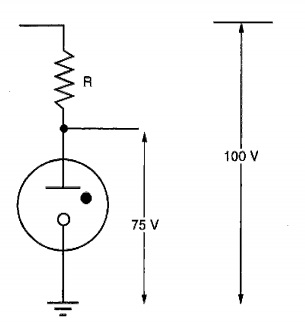
7. Look at the schematic drawing shown in the figure above. Assume that the average load current in the circuit is 20 mA. The value of the resistor should be approximately
A. 3,750 ohms.
B. 5,000 ohms.
C. 1,250 ohms.
D. 1,875 ohms.
8. Which of the following is a circuit that produces only one output pulse of direct current for each complete AC input cycle?
A. A voltage regulator
B. An oscillator
C. A half-wave rectifier
D. A full-wave rectifier
9. In an SCR, which of the following parts serves to turn the device on?
A. The anode
B. The gate
C. The diode
D. The cathode
10. Which of the following actions will occur when a zener diode starts to conduct?
A. The current through the diode remains constant, even if the voltage across the diode changes.
B. The current through the diode and the voltage drop across the diode both remain the same.
C. The voltage across the diode remains constant, even if the current through the diode changes.
D. The voltage drop across the diode becomes inversely proportional to the amount of current through the diode.
11. Which of the following statements about circuit grounding is correct?
A. A half-wave rectifier with a capacitive-input pi filter can’t be earth-grounded to the ground side of the AC power line.
B. A half-wave rectifier with an inductive filter can’t be earth grounded to the ground side of the AC power line.
C. A half-wave voltage doubler can’t be earth-grounded to the ground side of the AC power line.
D. A full-wave voltage doubler can’t be earth-grounded to the ground side of the AC power line.
12. Which of the following is a circuit that’s used to produce a high-frequency AC output from a DC supply?
A. An oscillator
B. A rectifier
C. A voltage regulator
D. An amplifier
13. Which of the following is a resistive network that’s connected across the output of a power supply and used to provide two or more output voltages?
A. A bleeder resistor
B. A voltage divider
C. A switching regulator
D. A choke-input filter
14. Which of the following is the voltage that a rectifier diode must be able to withstand when it is not conducting?
A. The conduction voltage
B. The reverse current transfer voltage
C. The peak inverse voltage
D. The RMS value of inverse voltage
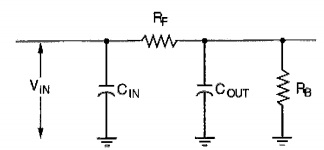
15. Look at the schematic diagram that’s shown in the figure above. Which of the following provides most of the filtering of the pulsations in
16. When the load on a rectifier circuit increases, the diodes in the rectifier will conduct when the load is light.
A. less erratically than
B. less than
C. more than
D. the same as
17. Which of the following circuits is used to convert alternating current into direct current?
A. A voltage regulator circuit
B. A rectifier circuit
C. An inverter circuit
D. A filter circuit
18. Why is the output of a full-wave rectifier easier to filter than that of a half-wave rectifier?
A. Because only one DC output pulse is supplied for each applied cycle of AC input
B. Because fiill-wave rectifier circuits contain fewer diodes than half-wave rectifiers
C. Because the frequency of the output pulsation is higher in a full-wave rectifier
D. Because the frequency of the output pulsation is lower in a full-wave rectifier
19. To change a DC voltage to some other value of DC voltage, you would need to use a/an
A. bridge rectifier.
B. inverter.
C. choke-input filter.
D. converter.
20. A full-wave, single-phase bridge rectifier is different from a standard fiill-wave, single-phase rectifier in that the bridge rectifier uses
A. one-fourth as many diodes as the standard rectifier.
B. one-half as many diodes as the standard rectifier.
C. twice as many diodes as the standard rectifier.
D. four times as many diodes as the standard rectifier.
Exam: 002909RR – Practical Exercise 9
When you have completed your exam and reviewed your answers, click Submit Exam. Answers will not be recorded until you hit Submit Exam. If you need to exit before completing the exam, click Cancel Exam.
Questions 1 to 20: Select the best answer to each question. Note that a question and its answers may be split across a page break, so be sure that you have seen the entire question and all the answers before choosing an answer. Use this illustration to answer the following question.
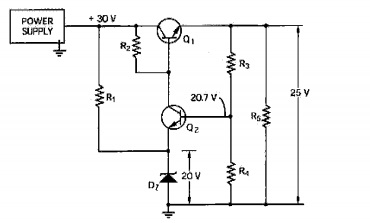
1. In the circuit shown, an electronics technician measures the output voltage of the regulator circuit at 30V. Which of the following statements about this circuit is correct?
A. Resistor R2 is shorted.
B. Resistor Rj is open.
C. The collector-to-emitter junction is open in
D. Resistor R4 is open.
2. To recover audio from a received single sideband signal, the receiver must
A. contain a balanced modulator.
B. have several stages of frequency multiplication.
C. have an extremely narrow bandwidth.
D. reinsert the missing carrier.
Use this illustration to answer the following question.
3. In the circuit illustrated in the figure, which of the following are frequency-determining components?
A. R2 and R5
B. R} and C4
C. R} and R2
D. Cj and R3
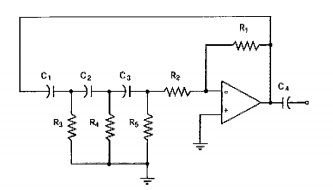
4. For a circuit to oscillate, it’s absolutely essential that the circuit have
A. a gain of less than unity.
B. degenerative feedback.
C. regenerative feedback.
D. negative resistance.
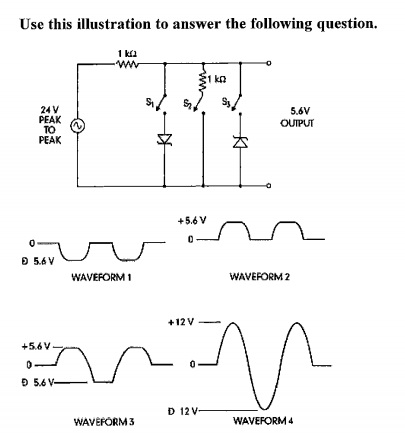
5. Look at the circuit diagram and the four waveforms that are shown. Which of the following waveforms will be produced when only Sj is closed?
A. Waveform 1
B. Waveform 2
C. Waveform 4
D. Waveform 3
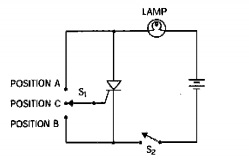
6. Look at the schematic diagram shown in the figure. In this circuit, the lamp will light only when
A. S2 is closed and Sj is in position A, position B, or position C.
B. S2 is closed and Sy is in position^.
C. $2 is closed and S} is in position A or position B.
n.s2 is closed and Sj is in position B.
7. Which of the following represents an invalid DTMF tone pair?
A. 1633 and 1477
B. 941 and 1209
C. 1336 and 852
D. 1336 and 770
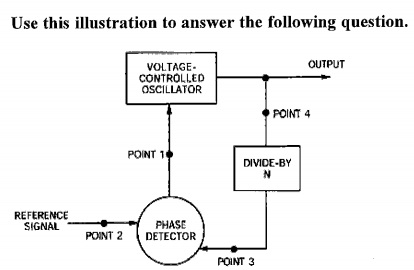
8. In the circuit illustrated, which of the following factors determines the accuracy of the output frequency?
A. The accuracy of the divider
B. The accuracy of the reference signal
C. The stability of the VCO
D. The stability of the phase detector
9. A modulation technique that uses two tones that are separated in frequency is called
A. SSB.
B. CTSS.
C. FSK.
D. DTMF.
10. At which of the following points in the circuit shown would it be normal to measure a varying DC voltage?
A. Point 2
B. Point 1
C. Point 3
D. Point 4
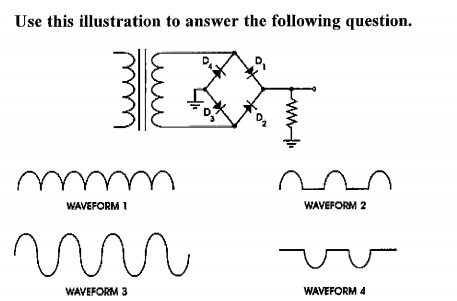
11. Look at the circuit diagram and the four waveforms that are shown. Which of the four ripple waveforms shown would result if were to open?
A. Waveform 4
B. Waveform 2
C. Waveform 1
D. Waveform 3
12. Which of the following does a relaxation oscillator depend on for proper operation?
A. Negative feedback
B. Negative resistance
C. Frequency synthesis
D. Positive feedback
Use this illustration to answer the following question.
13. For the circuit shown, what countdown is necessary from the divider circuit to produce an output frequency of 10 MHz? (Assume a reference frequency of 100 kHz.)
A. 100
B. 10
C. 1,000
D. 10,000
Use this illustration to answer the following question.
14. When a load is applied to the power supply in the circuit shown, the output voltage tends to decrease. Which of the following actions in the circuit counteracts this tendency?
A. The voltage at the junction of and R4 increases.
B. The voltage at the emitter of increases.
C. The conduction of Q2 decreases.
D. The conduction of Ql decreases.
Use this illustration to answer the following question.
oscillator.
A. twin-T
B. Wein bridge
C. phase-shift
D. relaxation
Use this illustration to answer the following question.
WAVEFORM 1 WAVEFORM 2
16. Look at the schematic diagram and the four waveforms that are shown. Which of the following statements about this circuit is correct?
A. To obtain waveform 3 at the output of this circuit, only switch S2 must be closed.
B. To obtain waveform 3 at the output of this circuit, either switch Sj or switch S3 must be closed.
C. To obtain waveform 3 at the output of this circuit, both switch and switch S3 would have to be closed.
D. No combination of closed switches will produce waveform 3 at the output of this circuit.
Use this illustration to answer the following question.
17. Look at the block diagram shown. Which of the following multiplication factors must take place in the two unmarked stages to obtain the 60 kHz output?
A. x 6 and x 6
B. x 3 and x 2
C. x 6 and x 2
D. x 5 and x 5
18. Which of the following statements about series regulators is correct?
A. Series regulators are inherently less efficient than shunt regulators because the current through the shunt regulator flows through the load.
B. Series regulators are inherently more efficient than shunt regulators because the current through the shunt regulator flows through the load.
C. Series regulators are inherently less efficient than shunt regulators because the current through the shunt regulator doesn’t flow through the load.
D. Series regulators are inherently more efficient than shunt regulators because the current through the shunt regulator doesn’t flow through the load.
19. Look at the schematic diagram shown. This circuit diagram represents a/an
A. Wein bridge oscillator.
B. full -wave rectifier.
C. frequency synthesizer.
D. audio amplifier.
20. Look at the circuit diagram shown. An electronics technician measures a voltage of 25.7 V at the collector of Q^ Which of the following statements about this circuit is correct?
A. An emitter-to-base short is present in Q}.
B. Resistor is open in the circuit.
C. Resistor R3 has increased in value.
D. The circuit is operating normally.